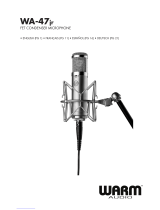
4
5
for the other directional characteristics, suitable for a
wide range of applications. The sound character of the
microphone is determined exclusively by the capsule;
no electrical equalization is used. The capsule is elas-
tically mounted to protect it from structure-borne
noise.
Via a special power supply, the five directional charac-
teristics omnidirectional, cardioid, figure-8, hypercardi-
oid and wide-angle cardioid can be selected by re-
mote control. The directional characteristic switch on
the front of the microphone must be set ”R“ (re-
mote control).
The hypercardioid directional characteristic is superior
to the cardioid in suppressing sounds to the left and
right of the source, while the wide-angle cardioid is
especially advantageous for recording large sound
sources (see Section 3.2.2).
Two additional switches are located on the back of
the TLM 127 microphone. The left switch reduces
the sensitivity of the microphone by 14 dB, and should
be used only when there is a risk that very high sound
pressure levels could overload following devices. The
switch does not expand the dynamic range of the mi-
crophone, but rather shifts it upward by 14 dB to high-
er sound pressure levels.
The right-hand slide switch sets the cut-off frequency
of a high-pass filter built into the microphone. When
the ”LIN“ setting is used, a high-pass filter is activat-
ed which suppresses frequencies below 15 Hz by
12 dB/octave. When the filter is used, the cut-off fre-
quency is 100 Hz. Among other things, this setting
may be used to suppress the proximity effect.
2.1 Additional Hints for the Operating of
the TLM 127
When the microphone is switched on or off, brief nois-
es ensue, due to the build-up or reduction of internal
operating voltages. Similar noises occur when switch-
ing the directional characteristic, since in this case half
the capsule must be recharged.
In the TLM 127 the 14 dB reduction of the output
level is effected by decreasing the capsule polarizing
voltage (bias). Switching the preattenuation on and off
is therefore likewise accompanied by brief noises.
2.2 Microphone Versions and
Output Wiring
The following versions of the TLM 127 microphone
are available:
K 127 sehr ausgeglichene Frequenzgänge, die sie für
einen breiten Kreis von Anwendungen empfehlen. Der
Klang des Mikrophons wird ausschließlich durch die
Kapsel bestimmt, es wird keine elektrische Entzer-
rung vorgenommen. Die Kapsel ist zum Schutz gegen
Körperschallübertragung elastisch gelagert.
Mit einem entsprechenden Fernsteuernetzteil können
die fünf Richtcharakteristiken Kugel, Niere, Acht so-
wie Hyperniere und Breite Niere gewählt werden,
wenn der Richtcharakteristikumschalter am Mikrophon
in die Position R gestellt wurde.
Die Hyperniere gestattet – besser als die Niere –
rechts und links des aufzunehmenden Objekts pos-
tierte Schallquellen auszublenden, während die Brei-
te Niere vorteilhaft zur Übertragung ausgedehnter
Schallquellen eingesetzt wird (siehe dazu Kapitel 3.2.2).
Auf der Rückseite des Mikrophons TLM 127 befin-
den sich zwei weitere Schalter. Der linke senkt das
Übertragungsmaß des Mikrophons um 14 dB und sollte
nur verwendet werden, wenn bei sehr hohen Schall-
druckpegeln für nachfolgende Geräte die Gefahr der
Übersteuerung besteht. Der Schalter erweitert nicht
den Dynamikumfang des Mikrophons, sondern ver-
schiebt ihn um 14 dB zu höheren Schalldruckpegeln.
Der rechte Schiebeschalter ändert die Grenzfrequenz
eines im Mikrophon eingebauten Hochpasses. In der
Stellung LIN ist bereits ein Hochpass aktiv, der Fre-
quenzen unter 20 Hz mit 12 dB/Oktave unterdrückt.
Bei eingeschaltetem Filter liegt die Grenzfrequenz bei
100 Hz. Diese Position dient unter anderem der Un-
terdrückung des Nahbesprechungseffekts.
2.1 Einige Zusatzinformationen zum
Betrieb des TLM 127
Beim Ein- und Ausschalten des Mikrophons entste-
hen kurzzeitig Störgeräusche, die durch den Auf- und
Abbau der internen Betriebsspannungen bedingt sind.
Ähnliche Störungen entstehen beim Umschalten der
Richtcharakteristik, da hierbei eine Hälfte der Kapsel
umgeladen werden muß.
Die Absenkung des Ausgangspegels um 14 dB wird
beim TLM 127 durch eine Verringerung der Kapsel-
vorspannung erreicht. Ein-und Ausschalten der Vor-
dämpfung ist deshalb ebenfalls mit kurzen Störgeräu-
schen verbunden.
2.2 Ausführungsformen und Beschaltung des
Mikrophonausgangs
Das Mikrophon kann in folgenden Ausführungsformen
geliefert werden:
TLM 127TLM 127
TLM 127TLM 127
TLM 127 .............................. ni ...............................Best.-Nr. 08475
Ausführung mit 3-poligem XLR-Steckereinsatz und nik-
kelmatter Oberfläche. Erforderliches Gegenstück:
XLR 3 F.
Die Zuordnung der Mikrophonanschlüsse entspricht
DIN 45 599, Kennzeichen „I“ bzw. IEC 268-12 (pin.
conn. 130-x-IEC 02):
Die Modulationsadern liegen an Pin 2 und 3, die Ab-
schirmung an Pin 1.
Bei einem Schalldruckanstieg vor der vorderen Mikro-
phonmembran tritt an Pin 2 eine positive Spannung
auf.
TLM 127 mtTLM 127 mt
TLM 127 mtTLM 127 mt
TLM 127 mt ...................... sw ............................. Best.-Nr. 08486
wie oben, jedoch mit schwarzmatter Oberfläche.
2.3 Mikrophonkabel
Für das TLM 127 stehen folgende Kabel zur Verfü-
gung:
IC 3 mtIC 3 mt
IC 3 mtIC 3 mt
IC 3 mt ................................. sw ............................. Best.-Nr. 06543
10 m langes Mikrophonkabel, Durchmesser 5 mm, mit
Doppeldrallumspinnung als Abschirmung. Schwarz-mat-
te 3-polige XLR-Steckverbinder. Führt am Ausgang des
Netzgerätes die Modulation weiter.
ICIC
ICIC
IC
44
44
4 (10 m) ........................ ni ............................... Best.-Nr. 06547
ICIC
ICIC
IC
44
44
4
mtmt
mtmt
mt (10 m) ............... sw ............................. Best.-Nr. 06557
10 m langes Mikrophonkabel für Mikrophone mit Ge-
windeanschluß, Durchmesser 5 mm, mit Doppeldrall-
umspinnung als Abschirmung. Dreh- und schwenkba-
res Stativgelenk SGCD 3 (mt), 3-polige XLR-Steckver-
binder, der Gewindeanschluß hat 5/8"-27-Gang. Ein
Adapter für 1/2"- und 3/8"-Gewindezapfen wird mit-
geliefert.
ACAC
ACAC
AC
2222
2222
22 ........................................................................... Best.-Nr. 06598
0,3 m langes Adapterkabel mit einer 5-poligen XLR-
Buchse und einem 3,5 mm Stereoklinkenstecker, un-
symmetrisch, für den Anschluß des 5-poligen XLR-
Ausganges des Speisegerätes BS 48 i-2, der Matrixbox
MTX 191 A oder des N 48 R-2 an Geräte mit 3,5 mm
Stereoklinkenbuchse.
ACAC
ACAC
AC
2525
2525
25 ........................................................................... Best.-Nr. 06600
0,3 m langes Adapterkabel mit einer 3-poligen XLR-
Buchse und einem 6,3 mm Monoklinkenstecker, un-
symmetrisch, für den Anschluß des 3-poligen XLR-
Ausganges eines Speisegerätes BS 48 i oder N 48 i-2
an Geräte mit 6,3 mm Monoklinkenbuchse.
ACAC
ACAC
AC
2727
2727
27 ........................................................................... Best.-Nr. 06602
Y-Adapterkabel, 0,3 m lang, mit einer 5-poligen XLR-
Buchse und zwei 6,3 mm Monoklinkensteckern, un-
symmetrisch, für den Anschluß des 5-poligen XLR-
TLM 127TLM 127
TLM 127TLM 127
TLM 127 ............................ ni ................................ Cat. No. 08475
Version with male 3-pin XLR connector insert and
satin nickel finish. Requires XLR 3 F female connec-
tor.
Microphone wired as per IEC 268-12 (pin conn. 130-
x-IEC 02) or DIN 45 599 I.
Modulation is connected to pins 2 and 3; the shield
is connected to pin 1.
A sudden sound pressure rise in front of the front
diaphragm causes a positive voltage to appear at pin 2.
TLM 127 mtTLM 127 mt
TLM 127 mtTLM 127 mt
TLM 127 mt ...................... blk .............................. Cat. No. 08486
as above, but with matte black finish.
2.3 Microphone Cables
The following cables are available for the TLM 127
microphone:
IC 3 mtIC 3 mt
IC 3 mtIC 3 mt
IC 3 mt ................................. blk .............................. Cat. No. 06543
10 m microphone cable, 5 mm in diameter, with dou-
ble twist (double helix) braiding as shield. 3-pin XLR
connectors, matte black. For feeding the audio signal
to mixing consoles, etc.
ICIC
ICIC
IC
44
44
4 (10 m) ........................ ni ................................ Cat. No. 06547
ICIC
ICIC
IC
44
44
4 mt (10 m) ................ blk .............................. Cat. No. 06557
10 m microphone cable, 5 mm in diameter, with dou-
ble twist braiding as shield. 3-pin XLR connectors and
SGCD 3 (mt) rotatable swivel mount. It has a
5/8"-27 female thread that can be fastened to tripods.
A threaded adapter for 1/2"- and 3/8" studs is includ-
ed. Designed for microphones with a threaded con-
nection.
ACAC
ACAC
AC
2222
2222
22 ............................................................................ Cat. No. 06598
0.3 m adapter cable with a 5-pin XLR connector on
one end and an unbalanced 3.5 mm stereo jack on
the other end. It is used to connect the 5-pin XLR
output of the BS 48 i-2 power supply, the MTX 191 A
power amplifier, or the N 48 R-2 power supply to
units with a 3.5 mm stereo input.
ACAC
ACAC
AC
2525
2525
25 ............................................................................ Cat. No. 06600
0.3 m adapter cable with 3-pin XLR connector and a
6.3 mm mono jack, unbalanced. It is used to connect
3-pin XLR outputs of the BS 48 i or N 48 i-2 power
supplies to units with a 6.3 mm monojack input.
ACAC
ACAC
AC
2727
2727
27 ............................................................................ Cat. No. 06602
Y-cable, 0.3 m long, with a 5-pin XLR connector and
two 6.3 mm mono jacks, unbalanced. It is used to
connect 5-pin XLR outputs of the BS 48 i-2 power










